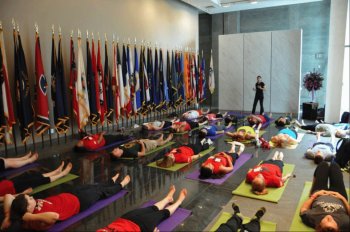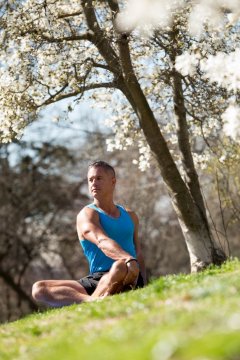
 Army Lt. Col. John Thurman lost 26 co-workers in the Sept. 11, 2001, attacks on the Pentagon. He suffered severe smoke inhalation while trapped in the building for 25 minutes. He spent a week in the hospital recovering.
Army Lt. Col. John Thurman lost 26 co-workers in the Sept. 11, 2001, attacks on the Pentagon. He suffered severe smoke inhalation while trapped in the building for 25 minutes. He spent a week in the hospital recovering.
In the months after the attacks, Thurman found he was suffering from post-traumatic stress disorder (PTSD). Thurman’s PTSD meant he wasn’t sleeping for months after the attack, even with the prescription drugs he was taking. And his pulmonary function hadn’t returned to full capacity.
But when Thurman started doing yoga, it “made all the difference in the world in my ability to deal with the stress and my injury from that day.”
He fell so in love with his time on the mat — with yoga’s traditional asanas, or poses, and deep breathing — that in 2013 he attended teacher training. He left his job at the Pentagon and is now teaching yoga full-time, including at the Pentagon Athletic Center, where his classes are packed.
Starting Friday night and running through Sunday, Thurman and 17 yoga teachers from five states will be gathering at Yoga Heights in the Park View neighborhood of the District for yoga for PTSD and trauma training. The studio will host workshops specifically designed to heal and help veterans suffering from both the emotional and physical wounds of war.
Army veteran John Thurman became a yoga teacher after the practice helped him recover from PTSD and other injuries after the 9/11 attacks on the Pentagon. (Courtesy of John Thurman)
Of the 2.3 million American veterans who returned from wars in Iraq and Afghanistan, more than 20 percent suffer from post-traumatic stress disorder, which often includes anxiety, depression, and hypervigilance, which means they feel always on guard.
Experts say that treatment for PTSD with painkillers, antidepressants and psychotherapy often have mixed results. The Veterans Health Administration has launched four pilot programs — including one in Richmond — offering yoga, acupuncture, Qigong, guided imagery and equine therapies, part of an effort to reduce the dependence of tens of thousands on opiate painkillers.
While doctors say the highly addictive drugs can help in the short term, they also can be harmful and often require another round of prescription pills to counteract side effects that can include insomnia, constipation, bone pain, anxiety and depression.
The alternative-therapy programs mark a dramatic departure in the treatment offered to troops who are returning from the wars in Iraq and Afghanistan and seeking relief from pain.
This weekend, Yoga Heights will have sessions titled, “The nervous system and using yoga as a therapeutic methodology, ” “Understanding veteran and military culture” and “Why yoga for trauma?”
 They will be hosting 15 hours of training.
They will be hosting 15 hours of training.
Jess Pierno’s job before she opened Yoga Heights with Amy Rizzotto, also a yoga teacher, was in the Office of the Secretary of Defense, where she started a lunchtime weekly yoga and meditation class for anyone who worked in the building.
“The yoga instructors who complete this training will be better equipped to teach students who have experienced trauma, by knowing how to mindfully adapt a typical yoga class setting and sequence to be more welcoming, comfortable and beneficial, ” said Pierno, whose studio has an activist spirit, offering some donation classes, classes at a local community garden and a free family class in Spanish at Mary’s Center.
Co-owner of Yoga Heights Jess Pierno used to teach yoga classes at the Pentagon. Now her studio is hosting training sessions to help veterans with PTSD. (Yoga Heights)
“Yoga is a very important healing tool, ” she added.
In the past, the ancient Indian practice was more typically associated with blissed-out yogis at an ashram, not former service members looking for inner peace.
But yoga is being increasingly embraced by Veterans Affairs and the military looking to move veterans off addictive painkillers and offer them alternative treatments for pain.
Yoga practices are designed to help calm the nervous system, she said.
Milwaukee’s VA, for example, rolled out an expanded yoga program for veterans in January. Warrior Stance is a free wellness program for all veterans. During one session, they had 25 veterans, double the number they thought would attend, the office told the local media.
In a recent study published in the Journal of Traumatic Stress, researchers say that they found scientific support that yoga can decrease stress and help move people away from negative and traumatic thoughts. The study was also the first of its kind to provide scientific support for the benefits of yoga’s breathing techniques for PTSD patients.
Thurman said he hopes the VA and Department of Defense will boost their programs and offer even more yoga to veterans.









